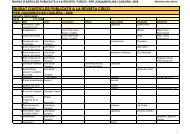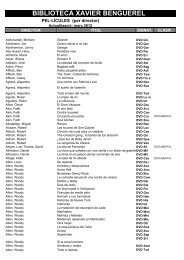The Early Cretaceous lizards of Montsec (Catalonia, Spain) - RACO
The Early Cretaceous lizards of Montsec (Catalonia, Spain) - RACO
The Early Cretaceous lizards of Montsec (Catalonia, Spain) - RACO
You also want an ePaper? Increase the reach of your titles
YUMPU automatically turns print PDFs into web optimized ePapers that Google loves.
For many years, these two specimens remained the only record <strong>of</strong> <strong>lizards</strong> from theearly <strong>Cretaceous</strong> <strong>of</strong> <strong>Spain</strong>. More recently, however, lizard remains have been recoveredfrom additional localities, most notably the late Barremian lithographic limestones<strong>of</strong> Ufla and Las Hoyas, both in Cuenca province, Castilla-La Mancha.<strong>The</strong> locality <strong>of</strong> Ufla (Cuenca province, Castilla-La Mancha) has yielded a variety<strong>of</strong> small vertebrates including a mammal, frogs, crocodiles, <strong>lizards</strong> and an early snakeFigure 2: Skull.A, Holotype <strong>of</strong> Ilerdaesaurus crusafonti H<strong>of</strong>fstetter, 1966 (MIPS, <strong>Montsec</strong> 10); B, Las 1-loyas 13510.Scale bars = 1 mm.Abbreviations: e, ?epipterygoid; j, jugal; jw, jaw; mx, maxilla; pf, postfrontal; po, postorbital; posq,impression representing postorbital and squamosal; pp, posterior process <strong>of</strong> parietal; prf, prefrontal; pt,pterygoid; q, quadrate; sq, squamosal; st, supratemporal.Figura 2: Cráneo.A, Holotipo de Ilerdaesaurus crusafonti H<strong>of</strong>fstetter, 1966 (MIPS, <strong>Montsec</strong> 10); B, Las Hoyas 13510.Scala= 1mm.Abreviaturas: e, ?epipterigoide; j, yugal; jw, mandIbula; mx, maxilar; pf, postfrontal; p0, postorbital;posq, impresión representando el postorbital y el escamoso; pp, proceso posterior del parietal; prf, prefrontal;pt, pterigoide; q, cuadrado; sq, escamoso; st, supratemporal.
(Richter 1991, 1994a&b). According to Richter (1994b), the <strong>lizards</strong> include four taxa,Ilerdaesaurus; two paramacellodids (cordyloid scincomorphs known from a range <strong>of</strong>late Jurassic and early <strong>Cretaceous</strong> assemblages) representing the genera Becklesiusand Paramacellodus, and a possible new anguimorph, Cuencasaurus (Richter,1994a&b). <strong>The</strong> material assigned to Ilerdaesaurus includes an associated skull(Richter, 1991, 1 994a) and a number <strong>of</strong> blocks bearing isolated cranial elements, apelvic girdle and some vertebrae. While it adds to our knowledge <strong>of</strong> the cranial morphology<strong>of</strong> the genus, this material does not contribute to discussion <strong>of</strong> the relationshipbetween Meyasaurus and Ilerdaesaurus.Frontals matching those <strong>of</strong> Ilerdaesaurus have also been recovered from the locality<strong>of</strong> Galve (Barremian, Teruel) (Richter, 1994a).Figure 3: Clavicles and interciavicles.A, Holotype <strong>of</strong> Meyasaurusfaurai Vidal, 1915 (MGB 534); B, LH 370; C, LH 372.Scale bars = 1mm.Abbreviations: c, clavicle; CR, cervical rib; ic, interclavicle; sc, scapulocoracoid.Figura 3: ClavIculas e interclavIculas.A, Holotipo de Meyasaurusfaurai Vidal, 1915 (MGB 534); B, LH 370; C, LH 372.Escalas= 1 mm. Abreviaturas: cl, clavIcula; CR, costilla cervical; ic, interclavIcula; sc, escapulocoracoides.
<strong>The</strong> locality <strong>of</strong> Las Hoyas lies close to Ufla, and its deposits may represent part <strong>of</strong>the same lacustrine system. Las Hoyas is currently being worked by a multidiscipli -nary international team, coordinated by the Universidad Autónoma de Madrid andfunded by the European Community. To date, the deposits have yielded a broad range<strong>of</strong> vertebrates and invertebrates. <strong>The</strong> tetrapod component includes frogs, salamanders,turtles, crocodiles, <strong>lizards</strong>, birds and an ornithomimosaurid dinosaur. To date, sevenlizard specimens have been recovered. Of these, one is an assemblage <strong>of</strong> dissociatedspecimens (probably a faecal or oral pellet) and two appear to belong to distinct andnovel taxa. Of the remainder, four (Museo de Cuenca LH 33, 370, 372, 13510) are <strong>of</strong>relevance to the <strong>Montsec</strong> <strong>lizards</strong>.<strong>The</strong>se specimens range in size from very small (LH 372, snout-vent length26mm), to medium-sized (LH 370, snout-vent 58mm) and three (except LH 33) preserveelements <strong>of</strong> both skull and postcranial skeletons.<strong>The</strong> skull (Fig. 2B, LH 13510) is distinctive -mostly notably in the presence <strong>of</strong> thelong frontals which are sharply constricted between the orbits, a single parietal withan anteriorly placed foramen, a posteriorly expanded and distinctly hooked squamosal,a slender jugal with a small posterior process, separate postfrontal and postorbitalbones, and a dentition in which the anterior teeth are monocuspid and the posteriorteeth bicuspid (LH 370, 372). In these features, the Las Hoyas <strong>lizards</strong> match specimens<strong>of</strong> Ilerdaesaurus from both <strong>Montsec</strong> and Uña.In the postcranial skeleton, the Las Hoyas <strong>lizards</strong> also show a number <strong>of</strong> significantfeatures: a cervical series <strong>of</strong> eight vertebrae in which the fourth to the six? bear shortexpanded ribs —the first <strong>of</strong> which is small and thick; the second is broader; the third islonger, expanded distally but waisted in the shaft. <strong>The</strong> vertebrae are procoelous, butweakly so with cartilage remaining over the condyle. <strong>The</strong> vertebrae in the thoracicregion have centra with grooved surfaces and a subrectangular appearance. With theexception <strong>of</strong> the first two, the thoracoabdominal ribs are very long (Fig. 1B), but thereis a marked change in length on the last 7/8 presacrals to create a discrete lumbar region.In the pectoral girdle, the clavicles are perforated but the borders are incomplete— a longanterior arm ends in a curved knob, the posterior arm is short (Figs. 1C, 3B-C). <strong>The</strong> lateralpart is flanged and S-shaped. <strong>The</strong> scapulocoracoids have two anterioemarginationsand a narrow scapula blade. <strong>The</strong> hands are long, with the third metacarpal longer thanthe fourth, and the fourth digit has five phalanges. In all <strong>of</strong> these features, except size(the largest Las Hoyas lizard, LH 370, is less than half the size <strong>of</strong> the <strong>Montsec</strong> skeleton),the Las Hoyas <strong>lizards</strong> match Meyasaurus. Although many <strong>of</strong> these are generalfeatures found in a number <strong>of</strong> modern <strong>lizards</strong>, the specific similarities in the shape <strong>of</strong>the clavicle, the appearance <strong>of</strong> the vertebral centra and the proportions <strong>of</strong> the ribs suggesta close relationship between Meyasaurus and the Las Hoyas <strong>lizards</strong>.<strong>The</strong> Las Hoyas <strong>lizards</strong> combine the skull <strong>of</strong> Ilerdaesaurus with the postcranialskeleton <strong>of</strong> Meyasaurus. This provides a clear indication that the two <strong>Montsec</strong> <strong>lizards</strong>
elong to a single genus. Meyasaurus Vidal 1915 has priority over IlerdaesaurusH<strong>of</strong>fstetter 1966; the latter should be considered a junior synonym <strong>of</strong> Meyasaurus.Meyasaurus is thus known from a series <strong>of</strong> Lower <strong>Cretaceous</strong> localities in <strong>Spain</strong>(<strong>Montsec</strong>, Uña, Las Hoyas, Galve), and ranges in age from Berriasian/Valangian tolate Barremian. It is also possible that Durotrigia H<strong>of</strong>fstetter 1967, based on an enigmaticjaw fragment from the Purbeck Limestone Formation (Beniasian) <strong>of</strong> Britain, isa related form.<strong>The</strong> associated skeletons <strong>of</strong> Meyasaurus from Las Hoyas (which will be describedin detail elsewhere, Evans and Barbadillo, MS) have permitted a more rigorousevaluation <strong>of</strong> the systematic position <strong>of</strong> the genus. Cladistic analysis (Hennig 86)using 149 derived character states to compare Meyasaurus with living lizard groupsand Sphenodon (Evans and Barbadillo MS), places Meyasaurus unequivocally in theScincomorpha, nested within Lacertoidea (teiids, gymnophthalmids, lacertids andxantusiids). <strong>The</strong>re is little basis for regarding Meyasaurus as an anguimorph(H<strong>of</strong>fstetter 1966, Richter 1991, 1994a).Within the abdominal cavity <strong>of</strong> the <strong>Montsec</strong> specimen, there are one or moresmall fish skeletons. This observation led Vidal (1915) to suggest that Meyasaurusmight be fully or partially aquatic. This hypothesis receives some support from therelative abundance <strong>of</strong> lizard specimens at the Las Hoyas locality, where terrestrialvertebrates are generally rare.ACKNOWLEDGEMENTSThis work was supported by EC Capital and Mobility Programme grant CHRXCT93 0164 which funds work on the Las Hoyas locality and its assemblage. Thanksare also due to Dr Julio Gómez-Alba at the Museu de Geologia de Barcelona, foraccess to the holotype <strong>of</strong> Meyasaurus faurai.Buscalioni, A. y Sanz, J. L. 1991. Los Reptiles diápsidos del <strong>Montsec</strong>. In: MartInez-DelclOs, X. (Ed.), Les Calcàries litografiques del Cretaci inferior del <strong>Montsec</strong>:Deu anys de campanyes paleontológiques, 89-93. Institut d'Estudis Ilerdencs,Lleida.Cocude-Michel, M. 1963. Les Rhynchocéphales et les Sauriens des calcaires lithographiques(Jurassique supérieur) d'Europe occidentale. (<strong>The</strong>se Univ. Nancy,1963). N. Arch. Mus. Hist. nat. Lyon, 7: 1-188.H<strong>of</strong>fstetter, R. 1966. Les Sauna (=Lacertilia) du Jurassique supérieur du <strong>Montsec</strong>h(Espagne). Bull. Soc. geol. France, 7: 549-557.
H<strong>of</strong>fstetter, R. 1967. Coup d'oeil sur les Sauriens (=Lacertiliens) des couches dePurbeck (Jurassique supérieur d'Angletene, Résumé d'un Mémoire). Colloq.Intern. C.N.R.S., 163: 349-836.H<strong>of</strong>fstetter, R, Crusafont, M. et Aguirre, E. 1965. Note préliminaire sur la presencede Sauriens (=Lacertiliens) dans le Jurassique supérieur du <strong>Montsec</strong>h (Espagne).C. r somm. Séanc. Soc. géol. France, 1965: 53-54.Huene, F. von. 1952. Revision der Gattung Pleurosaurus auf Grund neuer und alterFunde. Palaeontographica, A 101: 167-200.Lacasa, A. 1981. Estudio del yacimiento infracretacico del <strong>Montsec</strong> de Rubies, "LaPedrera de Meia". 159 pp. Institut d'Estudis Ilerdencs, Lleida.Richter, A. 1991. A new species <strong>of</strong> Ilerdaesaurus and other <strong>lizards</strong> from Ufla, <strong>Spain</strong>(Lower <strong>Cretaceous</strong>). In. Kielan-Jaworowska, Z., Heinz, N. and Nakrem, H.A.(Eds.), Fifth Symposium on Mesozoic Terrestrial Ecosystems and Biota,Extended Abstracts. Contrib. Pal. Mus., Univ. Oslo, 364: 55-56.Richter, A. 1994a. Der problematische Lacertilier Ilerdaesaurus (Reptilia, Squamata)aus der Unter-Kreide von Uña und Galve. Berliner geowiss. Abh., 13: 135-161.Richter, A. 1994b. Lacertilia aus der Unteren Kreide von Uña und Galve Spanien)und Anoual (Marokko). Berliner geowiss. Abh., 14: 1-147.Sanz, J. L., Wenz, S., Yébenes, A., Estes, R., MartInez-Declès, X., Jiménez-Fuentes,E., Diéguez, C., Buscalioni, A.D., Barbadillo, L. J. and Via, L. 1988. An early<strong>Cretaceous</strong> faunal and floral continental assemblage: Las Hoyas fossil-site(Cuenca, <strong>Spain</strong>). Geobios, 21: 611-638.Vidal, L. M. 1915. Nota geologica y paleontolOgica sobre el Jurásico superior de laprovincia de Lérida. Bol. Inst. Geol. Mi España, 36: 1-43.



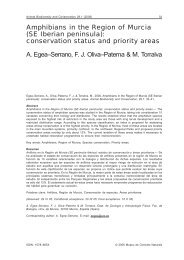
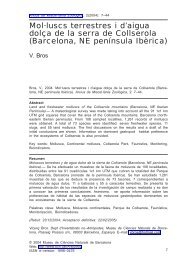
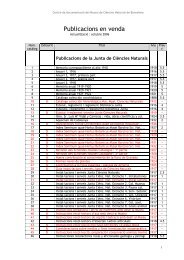
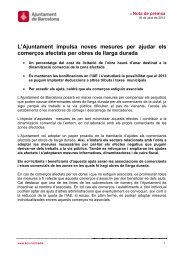
![[ pdf ] José Sanchis Sinisterra](https://img.yumpu.com/14886025/1/190x135/-pdf-jose-sanchis-sinisterra.jpg?quality=85)
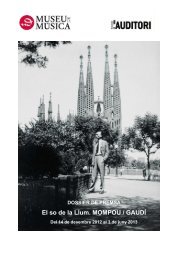
![[ pdf ] II Convenció Les veus de la gent gran 2004 - 2007](https://img.yumpu.com/14629010/1/190x182/-pdf-ii-convencio-les-veus-de-la-gent-gran-2004-2007.jpg?quality=85)

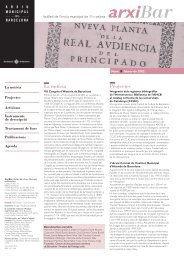

![[ pdf ] Material Escuela Pia Balmes](https://img.yumpu.com/14415004/1/184x260/-pdf-material-escuela-pia-balmes.jpg?quality=85)
